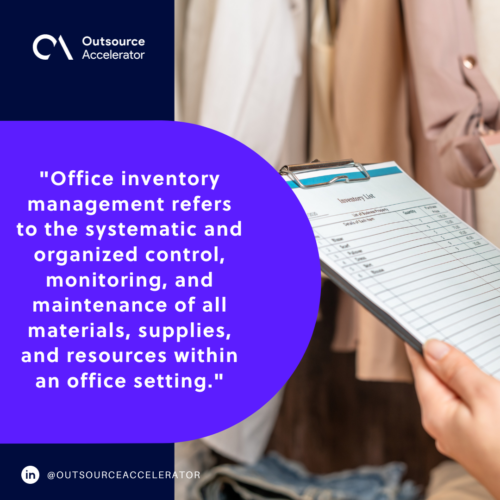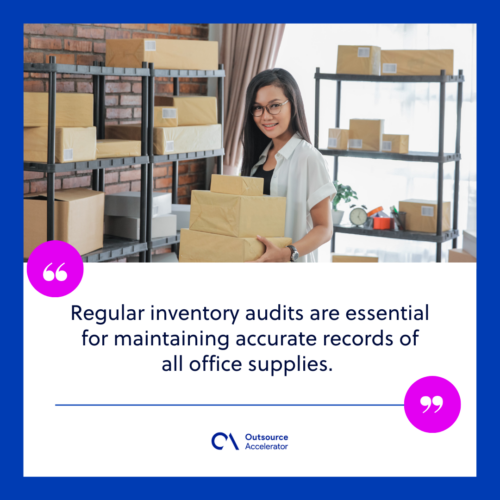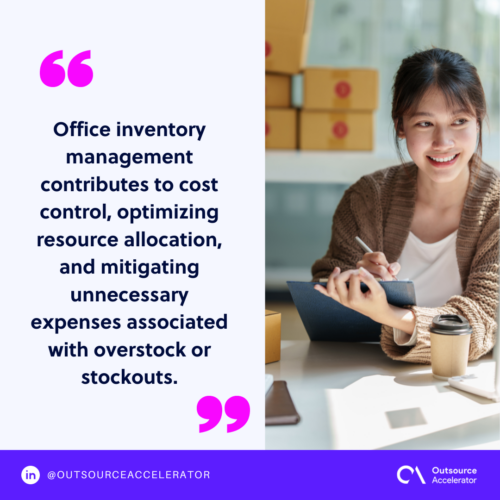7 office inventory management tips to remember

Office inventory may seem like an easy task of sorting and managing product stocks. Still, it’s actually an intricate office and warehouse process.
Each category of supplies demands unique considerations, such as tracking the usage patterns of frequently consumed items and planning for the timely replacement of outdated technology.
As workplaces continue to evolve and embrace technological advancements, the role of inventory management becomes even more critical.
Organizations that recognize the intricacies of this process are better positioned to thrive in the evolving business environment.
In this article, we’ll give you simple tips for efficient office inventory management.
What is office inventory management?
Office inventory management refers to the systematic and organized control, monitoring, and maintenance of all materials, supplies, and resources within an office setting.
It involves the strategic handling of various items, ranging from basic office supplies like pens, paper, and stationery. This extends more to substantial assets such as furniture, electronic devices, and equipment.
The primary goal of office inventory management is to ensure that the right quantity of supplies is available when needed.

Importance of managing office inventory
As mentioned, effective office inventory management ensures that essential supplies are consistently available.
Having the right resources at all times results in the following:
- It prevents disruptions in daily workplace operations.
- The availability of office tools contributes directly to maintaining a smooth workflow and overall productivity within the office.
- It not only helps keep a stock of tools in the workplace but also contributes to the optimal use of office space. Implementing organized storage systems and categorizing supplies enables businesses to maximize the efficiency of their physical workspace.
Office inventory management tips
Now, let’s explore seven practical tips to enhance your office inventory management process.
1. Conduct regular inventory audits
Regular inventory audits are essential for maintaining accurate records of all office supplies.
Conducting audits at regular intervals allows you to identify discrepancies, track usage patterns, and update inventory levels accordingly.
This office inventory management routine helps prevent stockouts and overstock situations, ensuring that the office has the right amount of supplies at all times.

2. Implement a centralized storage system
Having a centralized storage system is crucial for efficient office inventory management. This involves designating specific storage areas for different types of supplies.
This office inventory management practice makes it easier for employees to locate and retrieve items when needed.
A well-organized storage system also minimizes the risk of misplaced items and facilitates a more streamlined workflow.
3. Utilize inventory management software
Since we are now living in the digital age, why not leverage modern technologies?
Implementing inventory management software can significantly improve the accuracy and efficiency of tracking and managing supplies.
These tools often come with the following features that can make it easier for organizations to stay on top of their inventory:
- Real-time tracking
- Automated reorder notifications
- Detailed reporting
4. Set minimum stock levels
Establishing minimum stock levels for essential items is a strategic office inventory management approach. This aids against unexpected surges in demand or delays in the restocking process.
The key lies not only in setting these minimum levels but also in the regular review and adjustment of the products.
5. Rotate stocks regularly
Practicing regular stock rotation is a critical aspect of office inventory management, particularly for items with expiration dates. This strategy is instrumental in preventing wastage due to the expiration of perishable goods.
You can apply the first-in, first-out (FIFO) method to ensure that older items are utilized or sold before newer ones. This helps preserve the freshness and quality of perishable items.
This prevents financial losses associated with expired products and promotes a more cost-effective and sustainable approach to inventory control.
6. Categorize office supplies
Categorizing office supplies based on their nature and usage can enhance the efficiency of office inventory management.
Begin by creating clear categories for different types of items, such as stationery, electronics, and furniture.
This not only simplifies the tracking process but also facilitates better decision-making when it comes to reorder priorities and budget allocations.
7. Communicate with departments
Regular communication with different departments serves as a proactive measure to gain insights into their unique requirements and usage patterns. Through this, organizations can ensure that each department has the necessary supplies at the right time.
With effective communication, personnel assigned to office inventory management can create a precautionary rule that avoids unnecessary purchases within the department.
Office inventory management makes things easier
Implementing effective office inventory management practices is essential for maintaining a well-functioning workplace.
It contributes to cost control, optimizing resource allocation, and mitigating unnecessary expenses associated with overstock or stockouts.
Furthermore, efficient inventory management enhances workplace organization and creates a conducive environment for employees.
From conducting regular audits to utilizing advanced inventory management software—these tips can ensure a workplace that’s well-equipped to meet the demands of daily operations.








 Independent
Independent




